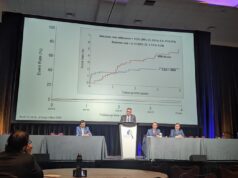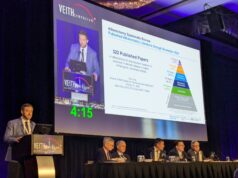BOCA RATON, FLA. – Coexisting subspecialty fellowship programs have at most only minimal adverse impact on general surgery residency training operative volumes, according to a national study sponsored by the American Board of Surgery.
The analysis also demonstrated that fellowship-bound general surgery residents tend to select additional cases in their chosen future subspecialty, thereby in effect creating a self-directed early tracking program, Dr. John B. Hanks said at the annual meeting of the American Surgical Association.
The American Board of Surgery (ABS) conducted the study in response to concerns that because 80% of general surgery residents pursue fellowship training, an insufficient number of cases could be available for resident training. But the national data indicate that this is not a problem, according to Dr. Hanks, professor and chief of general surgery at the University of Virginia, Charlottesville.
The study entailed detailed analysis of the operative logs of 976 applicants to the 2009 ABS qualifying exam. The applicants came from 246 general surgery residency programs. In all, 97 of these residency programs coexisted with a vascular surgery fellowship program, 35 with a colorectal surgery fellowship program, 80 with a minimally invasive surgery training program, and 12 with an endocrine surgery fellowship program. The investigators scrutinized case volumes for predefined key operations in the areas of vascular, colorectal, endocrine, and minimally invasive surgery (MIS).
Residents bound for fellowships in vascular, colorectal, and endocrine surgery performed significantly more total cases in each of those areas than did general surgery residents who were not bound for fellowships. For example, operative logs for the 90 vascular surgery fellowship–bound residents showed a mean experience of 165 vascular cases, compared with 123 cases for the other general surgery residents. And residents headed for colorectal surgery fellowships had a mean of 204 colorectal surgery cases, compared with 163 for all other general surgery residents.
In contrast, residents who were headed for an MIS fellowship and those who were not averaged a similar number of minimally invasive operations.
With regard to the effect of coexisting fellowship programs on general surgery residents’ operative experience in those specific areas, there was a negative impact only for MIS. Residents in general surgery training programs with a coexisting MIS fellowship averaged about 10% fewer MIS cases than did residents in institutions without a fellowship.
“That difference reaches statistical significance, although the practical significance of this effect may be open for debate,” Dr. Hanks observed.
The situation was different for residents at institutions with coexisting colorectal or vascular surgery fellowships; those fellowships had no impact on general surgery residents’ case volumes in those specialty-specific areas. And the presence of a coexisting endocrine surgery fellowship was actually associated with a significant increase in endocrine surgery case volumes for all residents, he continued.
Discussant Dr. Layton F. Rikkers cautioned that the ABS study describes national trends using broad strokes, and the data don’t necessarily apply to any individual residency program.
“As an example, the only fellowship we developed at the University of Wisconsin, Madison, during the time I was chairman there was a vascular surgery fellowship,” said Dr. Rikkers, professor of surgery at the university and past president of the ABS. “The year prior to developing the fellowship, our residents were in the 93rd percentile nationally with respect to vascular surgery cases done. Over the many years since that fellowship was established, our residents are in the 10th to 20th percentile for vascular surgery cases.”
Dr. Hanks declared having no financial conflict of interest.












